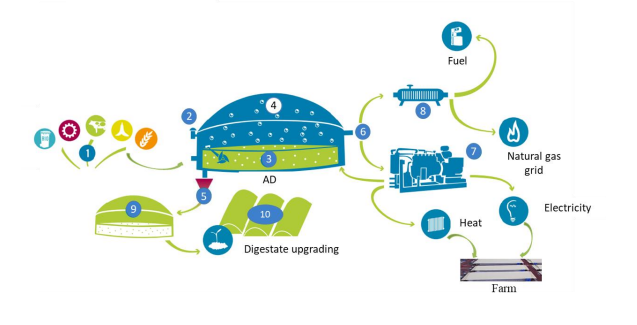Biomass is defined as organic matter derived from plants or animals available on a renewable basis. Cities can collect waste biomass to produce biogas, or can get the wood biomass from the region.
As it is distributed worldwide, one of the advantages of biomass utilization for energy is that almost every country can utilize its own resources. Moreover, since it is easy to store, it can be used for peak load generations of electrical energy.
Nevertheless, to ensure a secure supply, long-term contracts with the supplier need to be made. The suggested use for biomass in the city is a modern combined heat and power generation (CHP) connected to a district heating network or biofuels production. Although different sizes of biomass boilers that fit any need can be found on the market, domestic use of biomass should be avoided in the cities due to the emissions of fine particles that pollute the air.

Explanation: (1) Different feedstocks, (2) safety equipment, (3) anaerobic digester, (4) gas storage, (5) sanitation, (6) gas cleaning system for desulfurization, (7) combined heat and power unit (CHP), (8) gas treatment system for biogas upgrading (fuel and CNG), (9) Digestate storage, and (10) digestate upgrading (optional). Source: Practical biogas plant development handbook, https://open.unido.org/api/documents/25481236/download/Biogas%20handbook_English%20version.pdf
There are further high-efficiency biomass uses that have been rapidly increasing worldwide, such as fluidized bed combustion, co-firing with fossil fuels, CHP co-generation and gasification. A range of biomass pre-treatment and upgrading technologies, such as palletization, torrefaction, and pyrolysis, have been developed in order to improve biomass characteristics and to make handling, transportation and conversion processes more efficient and cost-effective. Anaerobic digestion for biogas production from wet biomass is a small-scale biomass CHP application. Biogas may also be upgraded to mix with natural gas and be used in natural gas grids or to power vehicles as compressed natural gas (CNG).
Comments ()